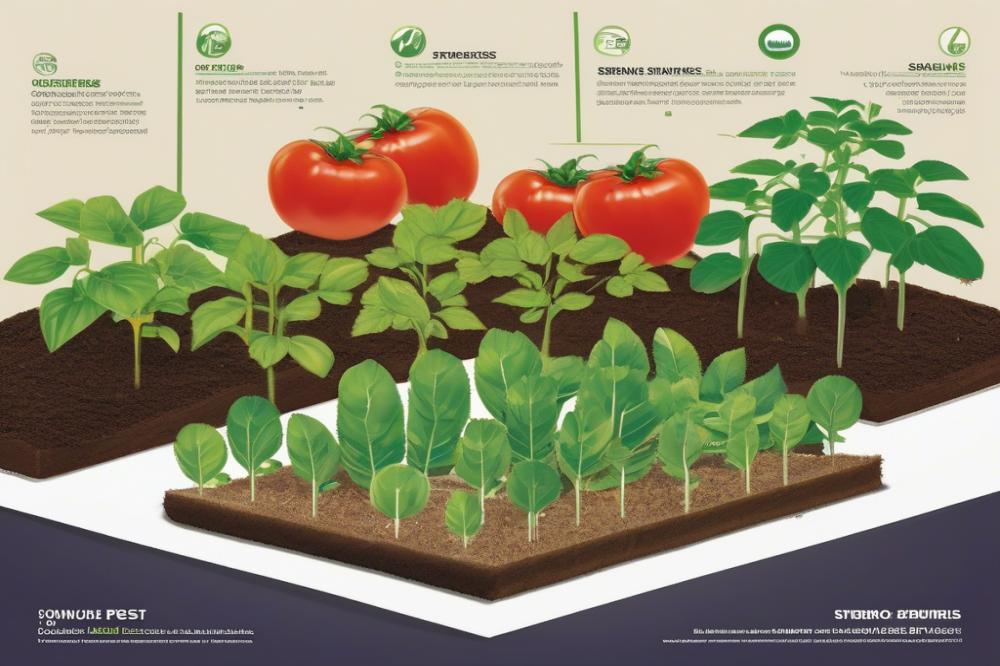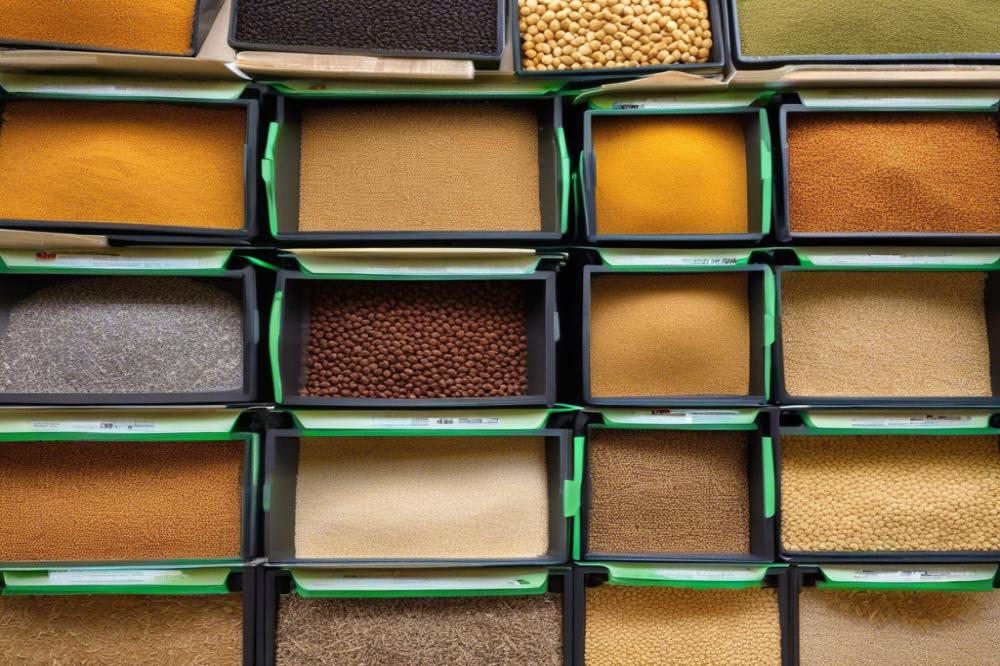Protecting Your Garden’s Future
In the world of gardening, seedlings represent potential. These young plants are the beginning of a fruitful harvest. Nurturing them requires careful attention, especially when it comes to pest threats. After all, healthy seedlings are essential for a thriving garden. Insects and diseases can quickly wipe out this early stage of growth, making seedlings protection a priority for any gardener.
common garden pests emerge during the warmer months. Aphids, slugs, and cabbage worms are just a few adversaries that can damage fragile seedlings. Each of these pests presents its unique challenges. Furthermore, they may multiply rapidly, leading to an overwhelming infestation. Therefore, being aware of these threats is critical for gardener’s success.
pest control is not a one-size-fits-all process. Various methods can be employed, from using natural repellents to practicing companion planting. organic gardening techniques often prioritize plant health while minimizing chemical applications. Maintaining healthy soil is foundational, as it supports robust plant growth. Additionally, using mulch can deter many pests and help regulate soil moisture.
Row covers offer physical barriers against insects, providing an extra layer of protection. Likewise, choosing pest-resistant plants can shield seedlings from common threats. The goal of this article is to equip you with practical strategies to combat these persistent issues. By implementing these techniques, you can create an environment that supports your seedlings while actively working to prevent pests.
Understanding common garden pests


Description of Common Pests that Target Seedlings
A variety of garden pests can pose serious threats to your seedlings. Aphids are tiny insects that often cluster on new growth. They suck the sap from young plants, weakening them over time. Another common pest is the cutworm, which can sever seedlings at the soil line. These pests often go unnoticed until damage occurs. Spider mites are also a problem, especially in dry conditions. They can create webbing and yellow spots on leaves. Each of these pests can stunt the growth of seedlings significantly if left uncontrolled.
Signs of Pest Infestation to Look For
Detecting pests early is crucial for effective pest control. Look for visible damage, such as holes in leaves or wilting plants. Sticky residue on leaves may indicate the presence of aphids. You might also spot the telltale silk webs made by spider mites. Another sign is the presence of eggs or larvae on the soil or leaves. Yellowing leaves can signal distress caused by pests or disease. Regular inspections will help you spot these signs before they escalate.
Life Cycles of These Pests and Their Impact on Seedlings
Understanding the life cycles of pests is key for proper seedling care. Many pests, like aphids, reproduce rapidly. They can lay dozens of eggs in just a few days. With favorable conditions, populations can explode, leading to severe infestations. Cutworms have a different cycle as they remain in the soil until they emerge as adults. This means they can attack seedlings before gardeners even realize they’re there.
A healthy soil system can naturally curb some pest populations. When your seedlings are under constant attack, it hinders growth and may even lead to diseases. Employing methods such as organic gardening can help in creating a pest-resistant environment. Using natural repellents or implementing companion planting strategies may also be effective. Covering plants with row covers helps form a barrier against insects, while mulch can offer additional protection. Overall, awareness and proactive measures are essential for the thriving life of your seedlings.
Effective Pest Control Strategies


Integrated pest management (IPM) is crucial for keeping seedlings safe. By combining different control methods, it helps reduce pest problems effectively. This approach balances environmental health and crop productivity. Embracing IPM means using both preventive measures and timely interventions.
When discussing pest control, two main categories emerge: chemical and organic options. Chemical solutions often work quickly, but they can harm beneficial insects and the soil. Organic alternatives, however, focus on natural repellents and sustainable practices. These methods tend to enhance soil health and promote biodiversity. Many gardeners prefer organic methods for their long-term benefits.
Organic gardening principles play a key role in pest prevention. Employing strategies like companion planting creates a natural balance in the garden. Certain plants repel pests, keeping seedlings safe. Using mulch around seedlings helps retain moisture and suppresses weeds. This practice not only provides a better environment for growth but also minimizes pest habitats. Row covers can protect young plants from insect damage while allowing light and moisture to reach them. Additionally, selecting pest-resistant plants is an excellent strategy for any gardener, as these varieties often withstand pest attacks better than others.
Maintaining healthy soil is essential for strong seedlings. Healthy plants are less likely to attract pests. Focusing on soil health through composting and organic amendments creates a rich environment for plants. Just as important is monitoring for any signs of disease. Early detection can prevent larger outbreaks, safeguarding your garden’s future.
Creating Healthy Soil for Disease Prevention


Healthy soil plays a crucial role in seedling growth. When soil is rich in nutrients, seedlings can develop sturdy roots. Strong roots mean better access to water and nutrients, which helps young plants thrive. Healthy soil also supports beneficial organisms that contribute to a balanced ecosystem.
Techniques for Enriching Soil Quality
Enriching soil quality can significantly enhance seedling care. One effective method involves adding organic matter like compost. This substance improves soil structure and increases its fertility. Mulch is another valuable addition. It not only retains moisture but also suppresses weeds, reducing competition for seedlings.
Practicing crop rotation can bring additional benefits. By planting different crops each season, you can minimize disease buildup in the soil. Companion planting is also effective. Certain plants can deter harmful insects when grown alongside your desired seedlings.
Beneficial Microbes and Their Role in Repelling Pests
Beneficial microbes are essential in maintaining healthy soil. These microorganisms help break down organic matter, making nutrients more accessible to plants. Some beneficial bacteria and fungi can also provide natural pest control. They produce compounds that repel harmful insects and diseases.
Integrating these microbes into your gardening practice can result in healthier plants. A diversity of soil life contributes to a robust ecosystem. Engaging with practices like using row covers can further protect seedlings. These covers shield young plants from pests while still allowing light and moisture to enter.
Incorporating pest-resistant plants into your garden can create a natural barrier. Selecting varieties that can withstand specific pests will limit the need for chemical interventions. Creating an ecosystem where beneficial insects thrive can lead to a reduced pest population. Each of these strategies contributes to effective disease prevention and promotes the growth of strong, resilient seedlings.
Natural Repellents and Homemade Solutions


Natural repellents offer effective ways to protect your seedlings from pests without using harsh chemicals. Many gardeners find that simple ingredients can work wonders. Common pests like aphids, spider mites, and caterpillars can be deterred using various natural methods.
List of Natural Repellents for Common Pests
Garlic is a powerful repellent due to its strong scent. It works against aphids and beetles. Soap spray targets numerous small insects while being gentle on plants. Diatomaceous earth is another option; it’s a fine powder that dehydrates insects when they come into contact with it. Neem oil serves as a natural insecticide that disrupts the life cycle of pests.
Recipes for Homemade Sprays Using Household Ingredients
Creating your own pest control solutions is easy and cost-effective. For a garlic spray, blend a few cloves with water, strain the mixture, and spray on your plants. This method can deter aphids and other harmful insects.
A simple soap spray requires mixing one tablespoon of liquid soap with a quart of water. Agitate well, then apply directly onto the affected leaves in the early morning or late evening to avoid harming beneficial insects. For diatomaceous earth, sprinkle it around the base of your seedlings or create a barrier on foliage to fend off crawling pests.
Advantages of Using Natural Methods in Organic Gardening
Utilizing natural repellents aligns with the principles of organic gardening. Healthy soil contributes to strong plant growth, making them naturally more resilient to pests. The use of these methods also promotes disease prevention by avoiding chemical residues that could harm beneficial organisms.
Companion planting enhances seedling care, allowing you to grow pest-resistant plants next to vulnerable ones. This strategy creates a balanced ecosystem in your garden. Moreover, cover crops and mulch provide additional layers of protection. These practices keep the soil moist while suppressing weeds, offering a more holistic approach to managing pests and nurturing your garden.
Row covers can physically block pests from reaching your precious seedlings. They protect young plants from insect damage while allowing sunlight and moisture to penetrate. By integrating these methods, you can create an environment that nurtures your seedlings, promoting both growth and health.
Companion Planting and Pest Resistance
Companion planting is a sustainable practice that involves growing different plants together for mutual benefits. This technique is rooted in the idea that certain plants can help each other thrive while deterring harmful pests. By intermingling crops, gardeners can experience a form of natural pest control, reducing the need for synthetic chemicals.
Some plants exhibit natural repellents, making them excellent companions. For instance, marigolds produce a scent that repels nematodes and other unwanted insects. Basil, when planted alongside tomatoes, can enhance flavor while reducing the attraction of tomato hornworms. Similarly, planting garlic or onions near roses can deter aphids due to their strong odor.
Healthy soil is vital for seedling care. Companion planting improves soil fertility and structure, which leads to stronger plants. When crops co-exist, they can also share nutrients, leading to improved growth and resilience. This diversity encourages beneficial insects, which help with pollination and pest control. Incorporating mulch in the garden can also aid this process by retaining moisture and suppressing weeds.
Row covers serve as an additional protective layer. They keep pests away while allowing sunlight and water to nourish the plants. Interplanting pest-resistant varieties can provide another layer of protection. For example, interspersing kale with herbs can reduce pest attraction and improve disease prevention.
Overall, companion planting is a wonderful strategy in organic gardening. It fosters a balanced ecosystem where plants support one another. Focusing on these relationships can lead to thriving seedlings and a healthier garden environment.
Utilizing Physical Barriers and Mulch
Importance of Using Row Covers to Protect Seedlings
Row covers are an excellent tool for seedling care. They act like a protective blanket, shielding young plants from harmful insects. By placing row covers over your seedlings, you can create a barrier that many pests simply cannot cross. This is especially useful during the early growing stages, when plants are most vulnerable. These covers also help create a warmer environment, which can boost growth. Plus, they allow sunlight to penetrate while keeping bigger pests at bay. Choosing lightweight materials for your row covers ensures that seedlings aren’t smothered. With proper placement, you can significantly enhance your organic gardening efforts.
Types of Mulch and Their Benefits in Pest Prevention
Mulch serves multiple functions in the garden, particularly in pest control. Many gardeners prefer using organic materials, like straw, grass clippings, or wood chips. These types not only improve the aesthetics but also contribute to healthy soil. A thick layer of mulch can smother weeds, depriving pests of their hiding spots. Additionally, some mulches can deter specific insects due to their texture or smell. For instance, cedar mulch is known for its natural repellents that ward off certain unwanted visitors. Opting for colored mulch can also confuse and deter pests, as they may not recognize their favorite targets easily.
Other Physical Barriers That Can Deter Pests
Beyond row covers and mulch, several other physical barriers can help create a pest-free environment. Fencing is a common choice, particularly for larger pests like rabbits or deer. Even simple chicken wire can provide an effective shield against these animals. Bird netting can protect seedlings from feathered friends that may peck at tender greens. Planting pest-resistant plants strategically around your garden can also serve as a defense. Utilizing companion planting allows for even more natural pest control methods. These tactics work together harmoniously, ensuring that your seedlings remain safe as they grow. Regular inspections of physical barriers are vital for ongoing disease prevention, as maintenance will keep your garden flourishing.
Maintaining Seedling Care and Observation
Caring for seedlings effectively fosters stronger plants. Best practices include providing adequate water and sunlight. Seedlings thrive in healthy soil, which contains nutrients necessary for growth. Regularly check the moisture level in the soil. Overwatering can lead to root rot, while underwatering stresses the plants. Mulch around seedlings helps retain moisture and reduces weed growth. It also creates a barrier against some insects, aiding in pest control.
Regular inspection of your seedlings is vital. Look for signs of pests or disease at least once a week. Early detection can significantly impact your gardening success. If you notice any holes in leaves or abnormal spots, investigate further. Taking action quickly can stop a small problem from becoming a larger one. Remember that pests often hide, so be thorough in your checks. Examine both the undersides of leaves and the soil.
Adjust your care based on the specific needs of your seedlings. Different plants have unique requirements regarding light, water, and nutrients. It may help to group seedlings with similar needs together. Using companion planting can provide benefits, as some plants naturally repel pests. Incorporate pest-resistant plants into your garden design for additional protection. Consider using row covers to shield sensitive plants from insects. These barriers allow sunlight and moisture through while keeping pests out.
Finally, employing organic gardening techniques can enhance the health of your seedlings. Use natural repellents made from garlic or pepper to deter unwanted pests. A healthy balance of nutrients and a focus on disease prevention are crucial. Overall, paying close attention to the needs of your seedlings not only promotes resilience but also leads to a more vibrant and fruitful garden.
Final Thoughts on Protecting Your Seedlings
Growing healthy seedlings can be challenging, especially when pests threaten them. To keep these young plants strong, consider the effective strategies we discussed. Using row covers can create a physical barrier, shielding your plants from harmful insects while allowing sunlight and rain to nourish them. Introducing beneficial insects, like ladybugs, can also help keep harmful pests in check naturally.
Crop rotation is another important step, as it disrupts pests’ life cycles. Keeping your garden clean and removing debris can prevent unwanted visitors. Additionally, practicing organic gardening allows you to cultivate a more balanced ecosystem, reducing the need for harsh chemicals. A well-maintained garden minimizes stress on plants and can lead to a stronger defense against pests.
Taking action now can set your seedlings on the right path for growth. Employing these methods not only safeguards your plants but also makes gardening a more rewarding experience. Every gardener can take part in pest control while promoting a vibrant garden ecosystem.
Remember, a thriving garden doesn’t just happen. It requires care, attention, and a bit of strategy. By embracing these approaches, you can cultivate a pest-resistant environment that nurtures your seedlings and satisfies your gardening passion.



